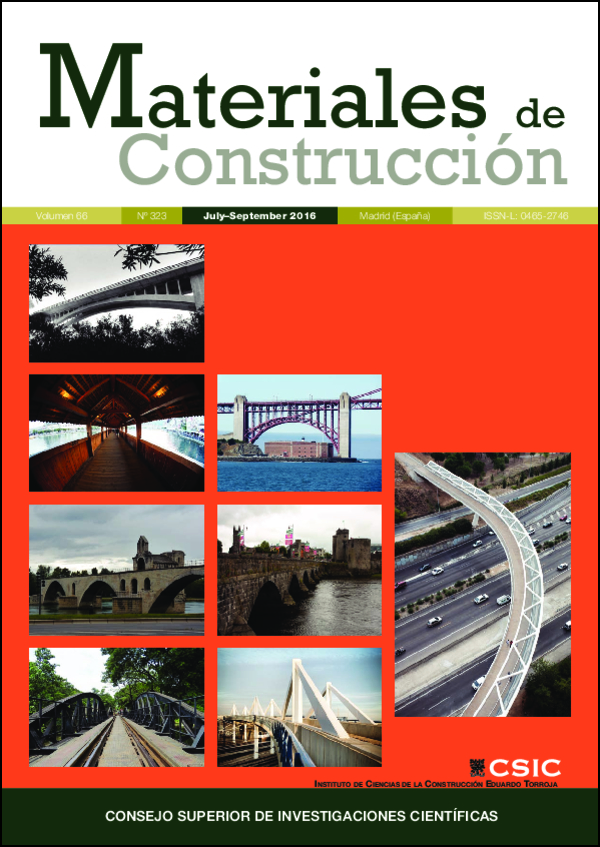El impacto sobre las propiedades mecánicas de la saturación de agua de los ladrillos cerámicos contemporáneos y del siglo XIX
DOI:
https://doi.org/10.3989/mc.2016.07315Palabras clave:
Ladrillo, Propiedades mecánicas, Resistencia a la CompresiónResumen
En el artículo se presentan los resultados del estudio de los ladrillos cerámicos producidos en los años 80 del siglo XIX. Los ladrillos se obtuvieron del edificio que forma parte de un conjunto de cuarteles del archiduque Rudolfo en Cracovia en Polonia. En los estudios se han determinado los cambios de la resistencia a la compresión y la dureza de los ladrillos, por efecto de la saturación de agua del material cerámico. A efectos comparativos, se han realizado también estudios de ladrillos producidos en la actualidad. Se ha comprobado que la saturación de agua de los ladrillos cerámicos lleva consigo una considerable disminución de las propiedades mecánicas. Por lo tanto, el impacto de la alta humedad de los ladrillos sobre el cambio de las propiedades mecánicas constituye un factor significativo en la evaluación de la seguridad en las construcciones de ladrillo.
Descargas
Citas
1. Foraboschi, P.; Vanin, A. (2014) Experimental investigation on bricks from historical Venetian buildings subjected to moisture and salt crystallization. Eng Fail Anal. 45, 185-203. http://dx.doi.org/10.1016/j.engfailanal.2014.06.019
2. Witzany, J.; Cejka, T.; Zigler, R. (2010) The effect of moisture on significant mechanical characteristics of masonry. Eng Struct Technol. 2, 79-85. http://dx.doi.org/10.3846/skt.2010.11
3. Matysek, P.; Witkowski, M. (2013) The assessment of humidity impact on the strength of brick masonry. Build Mater. 5, 10-12 [in Polish].
4. Amade A.M.; Martin J.V.; Colville, J. (2004). The effect of moisture on compressive strength and modulus of brick masonry. Proc. 13th International Brick and Block Masonry Conference. Amsterdam. PMid:15043442
5. Cultrone, G.; Sebastián, E.; de la Torre, M.J. (2005) Mineralogical and physical behaviour of solid bricks with additives. Constr Build Mater. 19, 39-48. http://dx.doi.org/10.1016/j.conbuildmat.2004.04.035
6. Elert, K.; Cultrone, G.; Navarro, C.R.; Pardo, E.S. (2003) Durability of bricks used in the conservation of historic buildings - influence of composition and microstructure. J Cult Herit. 4, 91-96. http://dx.doi.org/10.1016/S1296-2074(03)00020-7
7. Cultrone, G.; Sebastian, E.; Elert, K.; de la Torre, M.J.; Cazallo, O.; Navarro, C.R. (2004) Influence of mineralogy and firing temperature on the porosity of bricks. J Eur Ceram Soc. 24, 547-564. http://dx.doi.org/10.1016/S0955-2219(03)00249-8
8. Fernandes, F.M.; Lourenco, P.B.; Castro, F. (2010) Ancient clay bricks: manufacture and properties. In: Bostenaru Dan M; P?ikryl R; Török Á. Materials, Technologies and Practice. Historic Heritage Structures, Springer, (2010). http://dx.doi.org/10.1007/978-90-481-2684-2_3
9. Egermann, R.; Mayer, K. (1988) Die Entwicklung der Ziegelherstellung und ihr Einfluss auf die mechanischen Eigenschaften von Mauerziegeln. In: Erhalten historisch bedeutsamer Bauwerke - Baugefu -ge, Konstruktionen, Werkstoffe, Sonderforschungsbereich 315, Universit‰t Karlsruhe, Ernst und Sohn, Berlin, (1988).
10. Franke, L.; Schumann, I. (1998) A brief history of brickmaking in Northern Germany. In: Bear NS, Livingston RA, Fitz S. Conservation of Historic Brick Structures, United Kingdom: Donhead Publishing Ltd.
11. Nadachowski, F.; Jonas, S.; Wodnicka, K. (2003) Outline of Ceramography. Ceramics 82. PAN in Cracow and Polish Ceramic Society, Cracow (2003). [in Polish]
12. Hamilton, A.; Hall, C.; Pel, L. (2008) Sodium sulfate heptahydrate: direct observation of crystallization in a porous material. J Phys D Appl Phys. 41, (212002), 1-5. http://dx.doi.org/10.1088/0022-3727/41/21/212002
13. Stryszewska, T. (2014) The change in selected properties of ceramic materials obtained from ceramic brick treated by the sulphate and chloride ions. Constr Build Mater. 66, 268-274. http://dx.doi.org/10.1016/j.conbuildmat.2014.05.066
14. Benavente, D.; Linares-Fernandez, L.; Cultrone, G., Sebastian, E. (2006) Influence of microstructure on the resistance to salt crystallization damage in brick. Mater Struct. 39, 100-113.
15. Larsen, E.S.; Nielsen, C.B. (1990) Decay of bricks due to salt. Mater Struct. 23, 16 25. http://dx.doi.org/10.1007/BF02472994
16. Lubelli, B.; van Hees, R.; Grootb, J.W.P. (2004) The role of sea salts in the occurrence of different damage mechanisms and decay patterns on brick masonry. Constr Build Mater. 18, 119-124. http://dx.doi.org/10.1016/j.conbuildmat.2003.08.017
17. Monteiro, S.N.; Vieira, C.M.F. (2014) On the production of fired clay bricks from waste materials: A critical update. Constr Build Mater. 68, 599-610. http://dx.doi.org/10.1016/j.conbuildmat.2014.07.006
18. Cultrone, G.; Sebasti·n, E. (2009) Fly ash addition in clayey materials to improve the quality of solid bricks. Constr Build Mater. 23, 1178 1184. http://dx.doi.org/10.1016/j.conbuildmat.2008.07.001
19. Stryszewska, T. (2014) The influence of full water saturation on selected physico-mechanical properties of ceramic bodies. Ceram Mater. 66 [1], 81 87 [in Polish].
20. EN 772-1. Methods of tests for masonry units - determination of compressive strength. 2001.
21. Stryszewska, T. (2012) Selection of the diagnostic features of the studies the impact of water-soluble salts on the durability of ordinary bricks. Build Mater. 5, 69-71 [in Polish].
22. Sitarz, M. (2011) The structure of simple silicate glasses in the light of Middle Infrared spectroscopy studies. J. Non-Crystalline Solids 357, 1603-1608. http://dx.doi.org/10.1016/j.jnoncrysol.2011.01.007
23. Mozgawa, W.; Sitarz, M.; Rokita, M. (1999) Spectroscopic studies of different aluminosilicate structures. J. Molecular Structure 251, 511-512. http://dx.doi.org/10.1016/s0022-2860(99)00165-9
24. Awgustinik, A.J. (1980) Ceramic. Arkady, Warsaw, (1980). [in Polish].
25. Nadachowski, F.; Jonas, S.; Ptak, W. (2012) Introduction to technological design in ceramics. AGH; Cracow, (2012). [in Polish].
26. Malolepszy, J.; Wons, W. (2007 June) Influence of physicchemical properties of coal fly ash on construction ceramic products, In: Proceedings of Conference Matbud, Cracow, Poland; 340-348 [in Polish].
27. Neville, A.M. (1973) Properties of concrete. London: Pitman Publishing (1973).
Publicado
Cómo citar
Número
Sección
Licencia
Derechos de autor 2016 Consejo Superior de Investigaciones Científicas (CSIC)

Esta obra está bajo una licencia internacional Creative Commons Atribución 4.0.
© CSIC. Los originales publicados en las ediciones impresa y electrónica de esta Revista son propiedad del Consejo Superior de Investigaciones Científicas, siendo necesario citar la procedencia en cualquier reproducción parcial o total.
Salvo indicación contraria, todos los contenidos de la edición electrónica se distribuyen bajo una licencia de uso y distribución “Creative Commons Reconocimiento 4.0 Internacional ” (CC BY 4.0). Consulte la versión informativa y el texto legal de la licencia. Esta circunstancia ha de hacerse constar expresamente de esta forma cuando sea necesario.
No se autoriza el depósito en repositorios, páginas web personales o similares de cualquier otra versión distinta a la publicada por el editor.
















